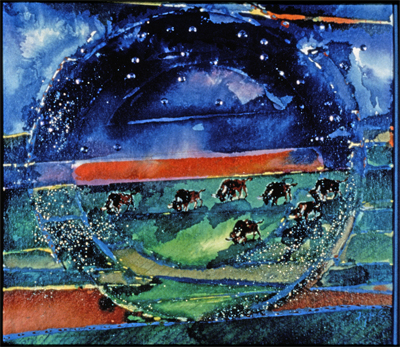The Hudson Bay Co., 1982
dick ibach
American (born 1940, died 2021)
Location: Washington State Arts Commission, Olympia
About the Artwork
‘The Hudson Bay Co.’ by dick ibach depicts three characters with a long, one-story building between them, and ibach’s signature bright colors and squiggly patterns all over. In the 1800s, the Hudson’s Bay Company controlled the fur trade in North America and had more than fifty trading posts. There are marked differences, and similarities, between the three characters, but the imagery suggests that the character on the left side is Native American while the two characters on the right side are fur traders or Hudson’s Bay employees. Animal skins are scattered around the scene, mostly on the right side. Many of ibach’s artworks suggest a story, but ibach also believes that you, the viewer, should interpret the story via the artwork’s “visual language” of colors, shapes, and textures.
This artwork was acquired for the State Art Collection in partnership with Washington State Arts Commission.
About the Artist
Spokane, Eastern Washington-based artist dick ibach (1940-2021) created paintings that combine figurative imagery with expressive forms, symbolism, and intense patterning. His art is humorous and often based on his memories: "It is my intention to speak of the contradictions of the human condition: to address both the nobility and stupidity of it all." He believes that the viewer must develop a “visual literacy” and not expect explanations, because “Artists are visual, and their imagery is visual… Words are for poets.”ibach was born and grew up in Yakima, Central Washington. He earned a Bachelor of Arts degree from Seattle University and a Master of Fine Arts degree from the Pratt Institute in Brooklyn, New York, in 1972. He taught art at Spokane Falls Community College for over fifteen years. He was also a Jesuit brother for ten years during the 1960s and he worked many odd jobs such as a hospital orderly, sod buster, cattle brander, grave digger, and cabinet maker. These experiences shaped his point of view as an artist.


_edited.jpg)


